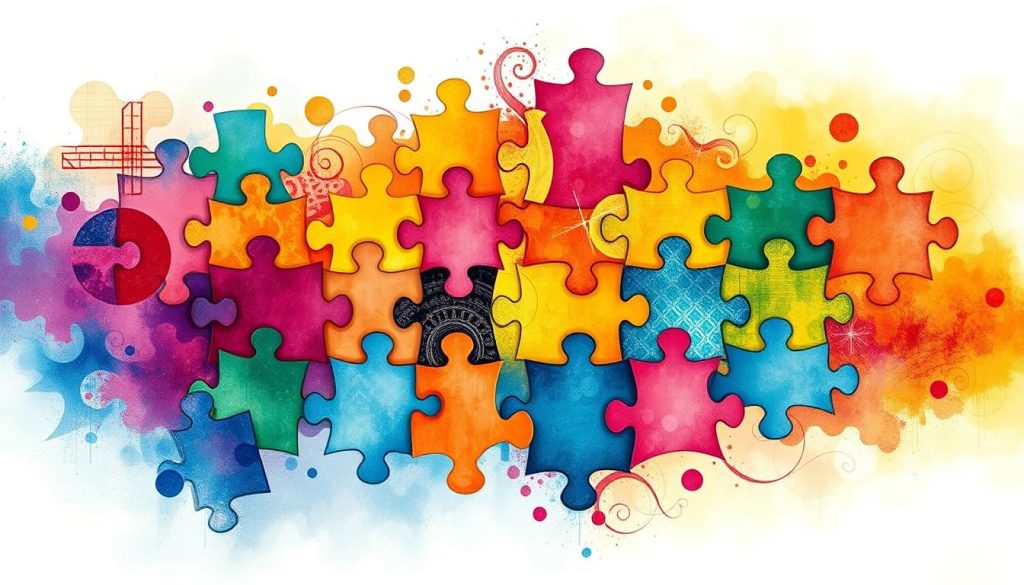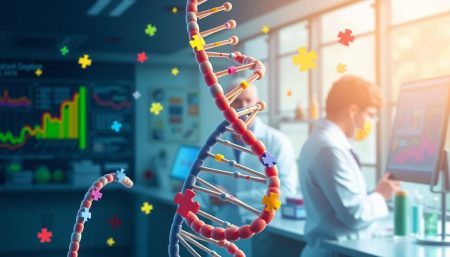Autism spectrum disorder is a complex developmental disability. It affects how people interact, communicate, and behave. This condition starts in early childhood and lasts a lifetime.
Those with autism often struggle in social situations. They may also show repetitive behaviors. The severity of symptoms can vary greatly, which is why it’s called a spectrum disorder.
Autism impacts brain development, changing how a person processes information. While there’s no cure, early diagnosis and support can greatly improve outcomes for those with autism spectrum disorder.
Understanding Autism Spectrum Disorder: A Basic Introduction
Autism spectrum disorder is a complex developmental disability. It affects how people communicate, interact, and behave. This condition varies from mild to severe. Let’s explore the basics of autism spectrum disorder to gain a better understanding.
Definition and Classification
Autism spectrum disorder is a neurodevelopmental condition. It brings challenges in social communication and repetitive behaviors. The Diagnostic and Statistical Manual of Mental Disorders (DSM-5) classifies it as a single disorder with varying levels of severity.
Historical Background
The term “autism” was first used in 1911 by psychiatrist Eugen Bleuler. In the 1940s, researchers Leo Kanner and Hans Asperger described autism in children. Our understanding of this developmental disability has evolved significantly over time.
Current Medical Understanding
Today, experts view autism as a spectrum of disorders. This shift recognizes the wide range of symptoms and abilities among individuals with autism spectrum disorder. Research continues to uncover new insights into its causes, diagnosis, and treatment options.
As we learn more about autism spectrum disorder, it becomes clear that early intervention and support are key. They help individuals with this developmental disability reach their full potentials.
What Is The Disease Autism: Medical Perspective
Autism is a complex condition that affects brain development and function. It’s not considered a disease but a spectrum disorder. This means symptoms can vary greatly among individuals.
Studies show autism causes changes in brain structure and connectivity. These changes affect how people with autism process information and interact with their surroundings.
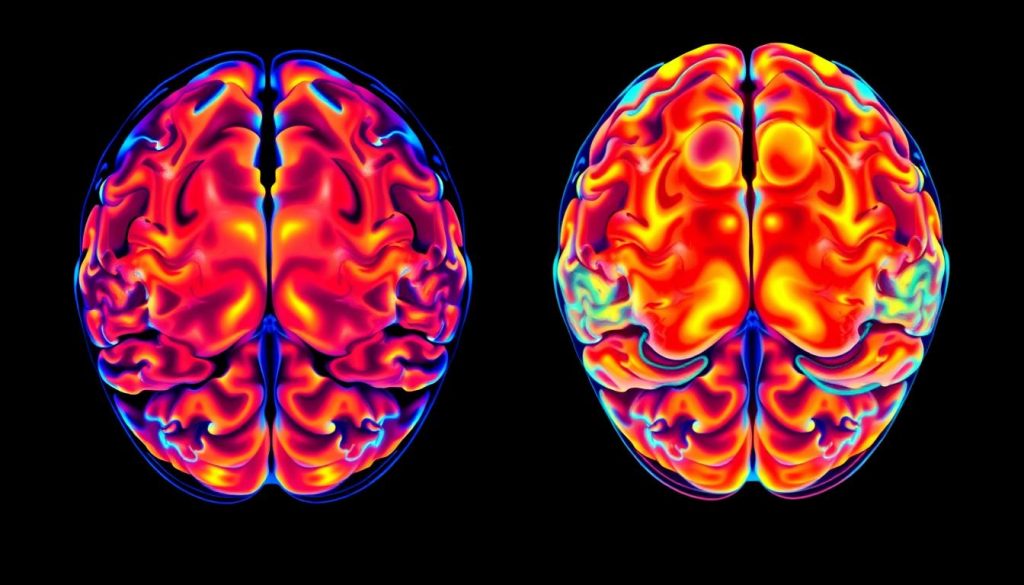
- Amygdala: Involved in emotional processing
- Cerebellum: Controls motor skills and balance
- Hippocampus: Plays a role in learning and memory
- Prefrontal cortex: Responsible for social behavior and decision-making
While the exact causes of autism are not fully known, genetics play a big role. Environmental factors may also contribute to autism symptoms.
| Brain Region | Function | Impact in Autism |
|---|---|---|
| Amygdala | Emotional processing | Difficulty recognizing emotions |
| Cerebellum | Motor skills, balance | Clumsiness, poor coordination |
| Hippocampus | Learning, memory | Challenges with verbal memory |
| Prefrontal cortex | Social behavior, decision-making | Difficulty with social interactions |
Ongoing research aims to understand more about autism’s biological roots. This knowledge will help create better diagnostic tools and treatments for those on the autism spectrum.
Signs and Symptoms of Autism Across Age Groups
Autism symptoms differ from person to person and can evolve as they grow. Spotting these signs early is vital for timely help and support. Let’s look at how autism shows up in various age groups.
Early Signs in Infants and Toddlers
Babies and toddlers with autism might act differently. They might not look at you, not answer when called, or speak late. Some don’t babble or point by 12 months. Early help is essential for their growth.
Behavioral Patterns in School-Age Children
School-age kids with autism often face social hurdles. They might find it hard to make friends or get social cues. They might also repeat actions, like lining up toys, or have strong interests.
These signs can affect their school life and social interactions.
Symptoms in Adolescents and Adults
As people with autism get older, their symptoms can change. Teens and adults might struggle with abstract thinking or sarcasm. They often prefer routines and find it hard to adapt to changes.
Some might excel in their interests but struggle with relationships or jobs.
Remember, autism symptoms vary a lot. If you see these signs, talk to a healthcare provider. Early intervention can greatly impact a person’s life with autism.
The Spectrum of Autism: Types and Severity Levels
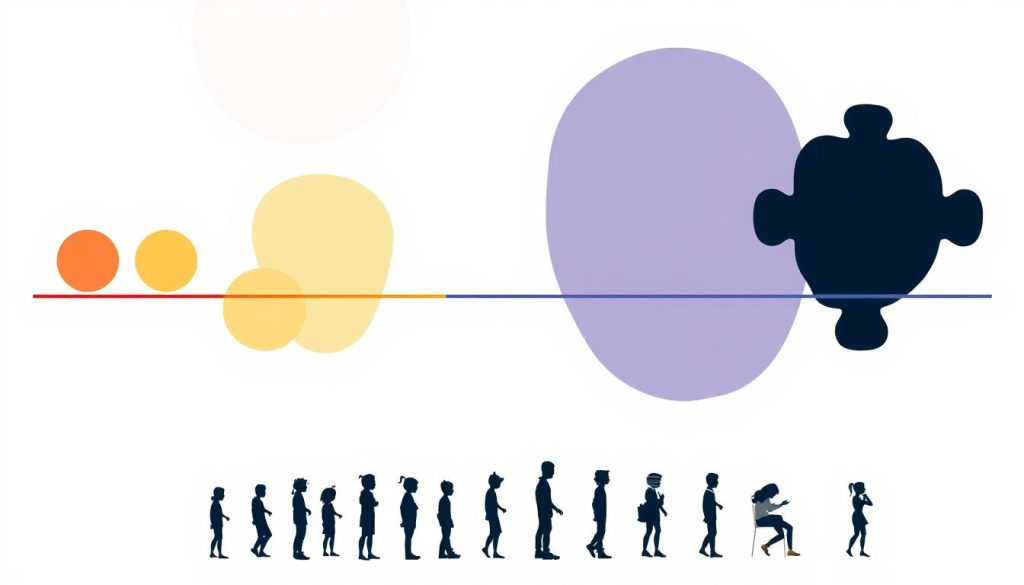
Autism spectrum disorder is a complex developmental disability. It affects people in different ways. The term “spectrum” shows the wide range of challenges and strengths people with autism may have.
The Diagnostic and Statistical Manual of Mental Disorders (DSM-5) lists three severity levels for autism spectrum disorder:
- Level 1: Requiring Support
- Level 2: Requiring Substantial Support
- Level 3: Requiring Very Substantial Support
These levels help doctors and therapists understand each person’s unique needs. For example, someone with Level 1 autism might struggle in social situations but can handle daily tasks. On the other hand, a person with Level 3 autism may need a lot of help with communication and self-care.
It’s important to remember that autism is not the same for everyone. Each person with autism spectrum disorder has their own strengths and challenges. Some might be great at math or music, while others might have amazing memory skills.
Understanding the spectrum nature of autism is key. It helps families and professionals create support plans that fit each person’s needs. These plans can address specific areas like social skills, communication, and sensory sensitivities. By recognizing the diverse presentations of autism spectrum disorder, we can better support individuals in reaching their full potentials.
Common Characteristics and Behaviors in Autism
Autism symptoms vary a lot, but some traits are common. People with autism often face unique challenges in everyday life. Let’s explore the key features that define this complex condition.
Social Communication Challenges
Many individuals with autism struggle with social interactions. They might avoid eye contact or find it hard to understand facial expressions. Some have trouble starting or keeping conversations going. These difficulties can make forming friendships challenging.
Repetitive Behaviors
Repetitive actions are a hallmark of autism. This could mean repeating words, rocking back and forth, or lining up toys. Some people with autism stick to strict routines and get upset when these change. These behaviors can offer comfort in a world that often feels overwhelming.
Sensory Sensitivities
Sensory processing issues are common in autism. Some individuals may be overly sensitive to lights, sounds, or textures. Others might seek out intense sensory experiences. These sensitivities can make everyday environments like schools or stores challenging to navigate.
| Characteristic | Example | Impact |
|---|---|---|
| Social Communication | Avoiding eye contact | Difficulty making friends |
| Repetitive Behaviors | Lining up toys | Provides sense of order |
| Sensory Sensitivities | Covering ears in noisy places | Limits participation in activities |
Understanding these autism symptoms helps create supportive environments. By recognizing these traits, we can better support individuals with autism in their daily lives.
Causes and Risk Factors Associated with Autism
Scientists are working hard to understand what causes autism. They believe it’s a mix of genetics and environment that affects brain growth. Knowing this helps find autism early and treat it better.
Genetic Factors
Genetics are a big part of autism. If one twin has autism, the other twin is more likely to have it too. Some genes make people more likely to get autism. These genes affect how the brain grows and works.
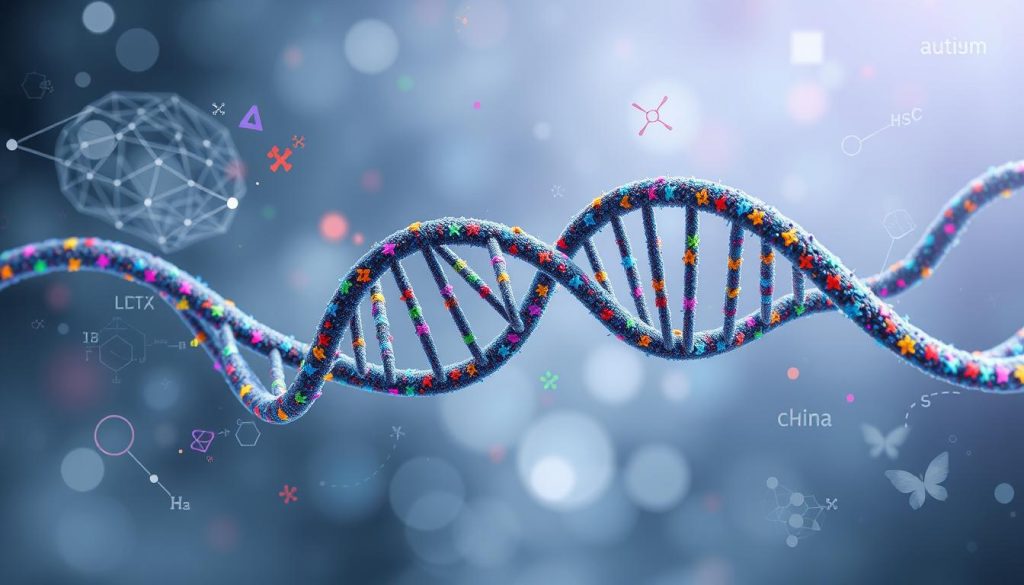
Environmental Influences
Things around us can also play a part in autism. Toxins, infections during pregnancy, and when parents have kids can be risks. Air pollution and some medicines during pregnancy might also raise the risk.
Prenatal Development
The time before a baby is born is very important for autism. Problems during pregnancy or birth can affect the brain. Things like diabetes or being overweight in pregnancy can also increase the risk. Getting good care before the baby is born is key.
| Factor | Potential Impact |
|---|---|
| Genetic Mutations | High risk for autism |
| Environmental Toxins | Moderate risk increase |
| Prenatal Complications | Slight to moderate risk increase |
| Parental Age | Slight risk increase |
We’ve learned a lot about autism, but there’s more to find out. Research keeps going to understand autism better. This will help us prevent and treat it more effectively.
Diagnostic Process and Assessment Methods
Getting an autism diagnosis is a detailed process. Doctors use many tools to check a person’s behavior, how they communicate, and their past development. They aim to spot autism spectrum disorder (ASD) early and accurately.
Screening usually begins with a questionnaire for parents about their child’s growth. If there are concerns, a deeper assessment is done. This might include:
- Watching the child’s behavior
- Tests for thinking and language skills
- Medical checks to rule out other issues
Doctors use specific rules from the Diagnostic and Statistical Manual of Mental Disorders (DSM-5) for an autism diagnosis. These rules look at social communication problems and repetitive actions.
The process of getting an autism diagnosis takes time. It often involves a team of experts, like psychologists, speech therapists, and occupational therapists. Each one adds their view to understand the person’s strengths and challenges fully.
| Assessment Tool | Age Range | Purpose |
|---|---|---|
| M-CHAT | 16-30 months | Screen for ASD risk |
| ADOS-2 | 12 months to adult | Observe social and communication behaviors |
| ADI-R | 2 years to adult | Structured interview with caregivers |
Early diagnosis is key for early help. It lets families get the right support and services, helping those with autism do better. Remember, an autism diagnosis is not just a label. It’s a way to understand and support someone.
Early Intervention Strategies and Their Importance
Early intervention is vital in treating autism. It can greatly improve a child’s life. Starting early leads to better outcomes.

Types of Early Interventions
There are many ways to help kids with autism early on. Some common types are:
- Speech therapy
- Occupational therapy
- Behavioral therapy
- Social skills training
Each child is unique, so the autism treatment plan should fit their needs.
Benefits of Early Treatment
Starting treatment early can lead to:
- Better communication skills
- Improved social interactions
- Fewer challenging behaviors
- Greater independence
These gains can last a lifetime and help kids reach their full potentials.
Family Support Systems
Families play a key role in early intervention. They can:
- Learn about autism
- Practice skills at home
- Work closely with therapists
- Connect with other families
With the right support, families can help their child thrive. Early intervention is a team effort that can lead to amazing progress.
Treatment Options and Therapeutic Approaches
Autism treatment includes many strategies, each tailored to the individual. Applied behavior analysis helps improve social skills and reduce challenging behaviors. Developmental interventions aim to enhance communication and cognitive abilities.
Educational approaches are vital in autism treatment. Special education programs offer structured learning environments. Speech therapy boosts language skills, while occupational therapy improves daily living abilities.
Some people may need medication to manage symptoms. Antipsychotics can help with aggression, and stimulants address attention issues. It’s important to work closely with healthcare providers to find the right treatments.
| Treatment Type | Focus Area | Typical Duration |
|---|---|---|
| Applied Behavior Analysis | Behavior modification | 20-40 hours/week |
| Speech Therapy | Communication skills | 1-2 hours/week |
| Occupational Therapy | Daily living skills | 1-2 hours/week |
| Social Skills Training | Peer interactions | 1-2 hours/week |
It’s important to remember that no single approach works for everyone. A mix of therapies often leads to the best results. Regular assessments and adjustments to treatment plans help ensure ongoing progress and support for individuals with autism.
Applied Behavior Analysis (ABA) Therapy
Applied behavior analysis is a top autism treatment that aims to improve specific behaviors. It uses a detailed method to understand and change behavior patterns in people with autism.
Principles of ABA
ABA therapy uses positive reinforcement to encourage good behaviors. It breaks down complex skills into smaller steps. Therapists watch and measure behavior changes to see how well it’s working.
Implementation Methods
ABA can be done in homes, schools, and clinics. Therapists use methods like discrete trial training and naturalistic teaching. They make plans that fit each person’s needs and goals.

Success Rates and Research
Research shows ABA therapy can help many with autism. Studies find improvements in communication, social skills, and adaptive behaviors. While results vary, many children make big strides with regular therapy.
| Skill Area | Percentage of Children Showing Improvement |
|---|---|
| Communication | 75% |
| Social Skills | 68% |
| Adaptive Behaviors | 70% |
Even though ABA is common, each child reacts differently. Families should team up with experts to find the best treatment for their loved ones.
Educational Support and Academic Accommodations
Students with autism face unique challenges in school. Tailored educational support is key for their success. Schools now offer various accommodations to help these students thrive academically and socially.
Individualized Education Programs (IEPs) are at the heart of autism treatment in schools. These plans outline specific goals and strategies for each student. They may include extra time on tests, quiet workspaces, or visual aids to support learning.
Inclusive education is becoming more popular for students with developmental disabilities. This model places children with autism in general education classrooms with additional support. It promotes social interaction and peer learning while providing necessary assistance.
- Specialized training for teachers
- Assistive technology in classrooms
- Sensory-friendly learning spaces
- Social skills groups
Many schools now employ autism specialists to guide teachers and develop strategies. These experts help create a supportive environment for students across the autism spectrum. They also work with families to ensure consistent support at home and school.
Academic accommodations extend beyond the classroom. Extracurricular activities are adapted to include students with autism. This holistic approach addresses social development alongside academic growth, essential for long-term success.
Managing Sensory Processing Issues
Sensory processing issues are common in autism. People with autism see the world differently through their senses. These challenges can impact daily life, but there are ways to help.
Types of Sensory Challenges
Sensory challenges vary a lot. Some people are too sensitive to sounds, lights, or textures. Others might seek out intense sensory experiences. Understanding these differences is key to providing support.
Coping Strategies
There are many ways to cope with sensory processing issues. Some find comfort in weighted blankets or noise-canceling headphones. Others benefit from sensory breaks or specific exercises to manage sensory input. The best strategies often depend on the individual’s needs.
Environmental Modifications
Changing the environment can greatly help those with sensory sensitivities. This might include dimming lights, reducing noise, or creating quiet spaces. At home or school, these changes can make a big difference in comfort and focus for people with autism symptoms.
FAQ
Q: What is autism spectrum disorder?
A: Autism spectrum disorder (ASD) is a complex condition. It affects how people interact, communicate, and behave. It’s called a “spectrum” because it varies from person to person.
Q: What are the main symptoms of autism?
A: Autism symptoms include trouble with social communication and repetitive behaviors. People with autism might also be very sensitive to sounds or lights. They may struggle with changes in routine or understanding nonverbal cues.
Q: What causes autism?
A: The exact cause of autism is not known. It’s thought to be a mix of genetics and environmental factors. Genes and prenatal influences might increase the risk.
Q: How is autism diagnosed?
A: Autism diagnosis involves detailed evaluations by experts. They look at behavior, developmental history, and use screening tools. There’s no single test for autism, so diagnosis relies on observation.
Q: At what age can autism be diagnosed?
A: Autism signs can appear as early as 18 months. But, a reliable diagnosis usually comes by age 2. Many children are diagnosed later, which can delay early help.
Q: What is early intervention, and why is it important for autism?
A: Early intervention is support for young children with autism and their families. It’s key because it can greatly improve a child’s development and daily functioning. Starting early can lead to better outcomes.
Q: What is Applied Behavior Analysis (ABA)?
A: Applied Behavior Analysis (ABA) is a therapy based on learning and behavior. It’s used to improve social skills, communication, and learning in autism treatment. ABA is customized for each person and can be done in different settings.
Q: How do sensory processing issues affect individuals with autism?
A: Many with autism have sensory processing issues. They might be too sensitive or not sensitive enough to sounds, lights, or smells. These issues can cause discomfort, anxiety, or behavioral problems.
Q: Is there a cure for autism?
A: There’s no cure for autism, but treatments can help. Therapies and interventions can improve skills and manage symptoms. Treatment plans are tailored to each person’s needs and strengths.
Q: How can schools support students with autism?
A: Schools can help students with autism through IEPs, classroom accommodations, and special teaching methods. This might include visual supports, structured routines, and social skills training. Inclusive education helps students with autism succeed in regular classrooms.












